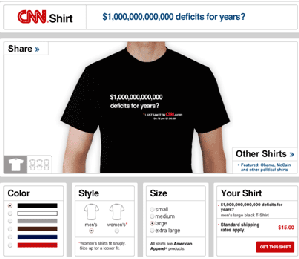Spreadshirt: Customers Want to Create Their Own Brands and Amplify Your Brand
Best Practices from the MIT Smart Customization Seminar 2008
Why do customers love to create their own T-Shirts? “If it’s not on a shirt, it didn’t happen,” says Jana Eggers, Spreadshirt’s CEO. Customers value the ability to create their own brands. They also love to personalize well-known brands. Big brands, like CNN and Coca-Cola partner with Spreadshirt so they can give customers the ability to “roll their own” personal versions of the name brands. By offering this personalization service, you can protect the integrity of your brand, yet empower your fans to make it their own!
SPREADSHIRT: MAKING IT EASY TO BE YOUR OWN BRAND
Like sneakers, custom-designed and printed T-shirts are a huge category in mass-customized products. Spreadshirt is one of the most mature companies in this space. It was founded in Leipzig in 2002 by Lukasz Gadowski and Matthias Spiess, and quickly became a European market leader in personalized clothing. The original idea wasn’t a direct-to-consumer play, but an online shop partner that would empower small retailers to create and sell their own branded goods. With the combination of a well-designed Web infrastructure and custom manufacturing expertise, the firm grew from a prototype to a multimillion Euro global company.
Refocus on Shirts and My Brand
Jana Eggers is now the CEO of this company, which has offices in Leipzig and Boston. “We’re a creative, personalized apparel company. We have millions of direct customers and over 300,000 shop partners.”
Jana told the story of the refocusing of Spreadshirt. “About a year ago, we refocused. We were producing a lot of custom merchandise: puzzles, clocks, lanyards, mugs, and, of course shirts. We went through a transition from “you think it, we’ll print it” to a laser focus on making it about them—the customers and the products that carry the most emotional impact for them.”
They did a lot of soul searching and research. “We asked our employees first; then we went to our customers.” They asked customers: “What made it “your own label?” Jana explained. What they discovered is that wearable apparel packed a lot more impact than any other customizable object. And that telling a story or making a statement about yourself is the key emotional driver. Jana said that the phrase that really summed up the customer research for her was: “I wear my shirt every time it’s clean.” This was the big epiphany. “Shirts are very personal to them. People comment on them. They wear them proudly. We also learned that the process of creation is a really important part of the perceived value of the experience. Many customers commented that they wanted to spend more time in creating their customized shirts; not less.”
Fast Turnaround and Scalability
Spreadshirt has two factories in Europe and one in the U.S. Most customized apparel is delivered within 24 to 48 hours. The company’s maturity as a mass-customizer gives it a leg up when dealing with large brands with mass audiences. Jana told the story of partnering with CNN. CNN wanted to offer the opportunity for customers to select a headline and get it printed on a CNN T-Shirt. “We were able to give CNN updates every 15 minutes on what shirts they were selling,” Jana commented.
CNN Partners with Spreadshirt
Make a Statement. CNN partnered with Spreadshirt to enable customers to make T-Shirts out of CNN headlines.
If It’s Not on a T-Shirt, It Didn’t Happen
Commemorate Events. Spreadshirt’s customers use shirts to mark important events in their lives!
Support Partners & Brands
More than 50 percent of Spreadshirt’s business is with established brands. Brands like Coca Cola, Warner Brothers, many content sites, and lots of community sites and entrepreneurs want to be able to offer their own branded apparel. Spreadshirt offers a cost-effective way for them to provide high quality with fast turnaround and no inventory.
Jana Eggers cited a number of different kinds of “shop partners” who routinely use Spreadshirt:
- Large brands like CNN, Coca-Cola, or Warner Brothers offer unique promotions
- E-commerce sites like Otto or Plus offer unique, personalized items
- Content sites like the Guardian, Boing Boing, or cartoonists Katz & Goldt offer brand extensions
- Community sites like ChuckNorrisFacts or Craftster.org offer “fanwear”
- Entrepreneurs like Nekkid Tees or Amorphia Apparel build their own apparel label
Commemorate Events
Many of these branded offerings take advantage of the customization capabilities. For example, Spreadshirt provides an easy-to-use fan site. “We do things like Tour shirts for Spice Girls. Fans pick their color, type of shirt, select and position the pre-approved art work. It makes them feel special.”
Whether the event is a rock concert, a family picnic, a company milestone, or a personal accomplishment, people apparently feel that “if it’s not on a T-shirt, it didn’t happen.”
Strut My Stuff
The other 50 percent of Spreadshirt’s business comes direct from consumers. Here are some interesting findings that Jana presented about her “direct-to-consumer” customers...
***
This case study is excerpted from my "Smart Customization Comes of Age," Best Practices report, January 8, 2009.
***
Sign in to download the full article
0 comments
Be the first one to comment.





